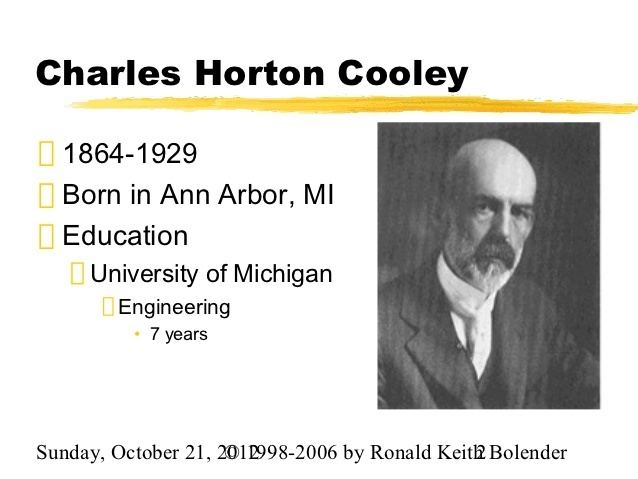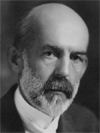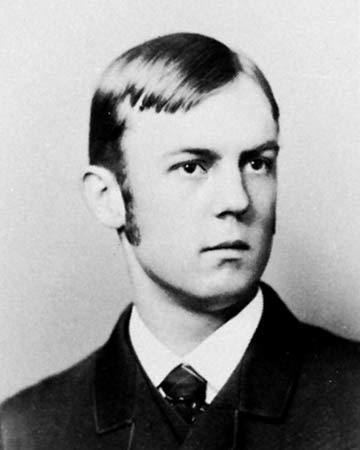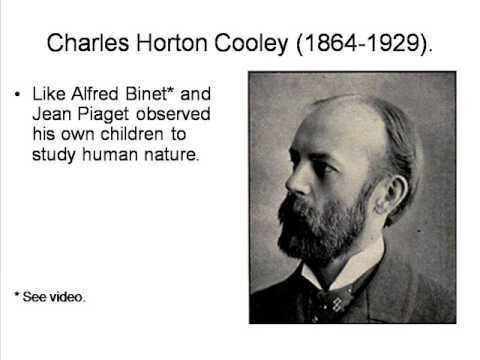Name Charles Cooley | Role Sociologist | |
 | ||
Parents Mary Elizabeth Horton, Thomas M. Cooley Books Human nature and the social, Social organization, On self and social organization, Life and the student, Social Process ‑ Scholar's Similar People George Herbert Mead, Herbert Blumer, Thomas M Cooley, W I Thomas, Robert E Park | ||
Introduction to sociology charles cooley looking glass self
Charles Horton Cooley (August 17, 1864 – May 7, 1929) was an American sociologist and the son of Thomas M. Cooley. He studied and went on to teach economics and sociology at the University of Michigan, and he was a founding member and the eighth president of the American Sociological Association. He is perhaps best known for his concept of the looking glass self, which is the concept that a person's self grows out of society's interpersonal interactions and the perceptions of others. He would eventually attain the title of president of the American Sociological Society, where he enjoyed the successful publishing of his work. At the end of his life he became very ill, and succumbed to an unidentified form of cancer in 1929.
Contents
- Introduction to sociology charles cooley looking glass self
- Charles cooley looking glass self
- Biography
- Education
- Family life
- Cooleys methodology
- Theory on transportation and the shift to sociology
- Social organization
- Social process
- Cooley and social subjectivity
- The Looking Glass Self
- Cooleys works
- Quotations
- References

Charles cooley looking glass self
Biography

Charles Horton Cooley was born in Ann Arbor, Michigan, on August 17, 1864, to Mary Elizabeth Horton and Thomas M. Cooley. His father was very successful in the legal field, and with a high social status he was well respected in the community. Thomas Cooley was the Supreme Court Judge for the state of Michigan, and he was one of the first three faculty members to start the University of Michigan Law School. He was then later appointed the dean at the law school from 1859-1884. His mother, Mary Elizabeth Horton took an active interest with public affairs and traveled with her husband to several cities around the United States in relation to the Interstate Commerce Commission. His father was a very successful man that stressed the importance of education to his six children. Nevertheless, Cooley had a difficult childhood and was somewhat of a passive child, and this exacerbated his feelings of detachment towards his father. The intimidation and alienation he felt by his own father at a young age took a toll in his life later on. Due to this situation, he suffered for fifteen years from a variety of illnesses, some appearing to be psychosomatic. He was shy and developed several insecurities due to his speech impediment, and lack of playmates. Cooley was a day dreamer and many of his "dreaming-life" had some form of influence to his sociological works. As a child he dealt with the feeling of isolation and loneliness, which led him to take an interest in reading and writing.
Education

At the age of sixteen Cooley started attending the University of Michigan. Cooley suffered from "obstetative elimination" which is an illness that affects the mental and physical health of individuals. His illness negatively affected his college life since it caused him to take breaks from studying. Due to the effects of this medical condition, it took Cooley a total of seven years to graduate from the University of Michigan in 1887. Charles continued with a year's training in mechanical engineering at the same school. In 1888, he returned for a master's degree in political economics, with a minor in sociology. He began teaching economics and sociology at the University in the fall of 1892. Cooley went on to receive a PhD in 1894. His doctoral thesis was The Theory of Transportation in economics. At this time he was interested in the subject matter of sociology, but due to the University of Michigan not having sociology as a department, he had to continue the examination of his PhD through Columbia University.

Since Cooley's father was honored nationwide, Cooley feared the idea of failure. He did not know where he belonged in life and did not know what he wanted to do with his life. He questioned if he wanted to study science, mathematics, social science, psychology or sociology. He wanted a job that allowed him to write and think, and after reading philosopher Herbert Spencer's works, Cooley realized he had an interest for social problems. He shared his reflections of the works of Spencer in 1920, citing that while he brought many valuable viewpoints with the subject of Darwinian principles, he lacks sympathy and the appropriate usage of the sociological perspective.
Cooley decided that he wanted to study sociology because it gave him the ability to think and analyze social problems. He began teaching sociology in the academic year of 1894 to 1895. He also had a very prominent role in the development of Symbolic interactionism, in which he worked heavily with another fellow staff member from the University of Michigan, psychologist John Dewey.
Family life
Cooley married Elsie Jones in 1890, who was the daughter of a professor of medicine at the University of Michigan. A highly cultivated woman, Mrs. Cooley differed from her husband in that she was outgoing, energetic, and hence capable of ordering their common lives in such a manner that mundane cares were not to weigh very heavily on her husband. The couple had three children, a boy and two girls, and lived quietly and fairly withdrawn in a house close to the campus. The children served Cooley as a kind of domestic laboratory for his study of the genesis and growth of the self. He would observe imitation behavior in his three children and analyzed these behaviors by comparing their ages and reactions. Even when he was not engaged in the observation of his own self but wished to observe others, he did not need to leave the domestic circle.
Cooley's methodology
Cooley is noted for his displeasure at the divisions within the sociological community over methodology. He preferred an empirical, observational approach. While he appreciated the use of statistics, he preferred case studies: often using his own children as the subjects on his observation. He also encouraged sociologists to use the method of sympathetic introspection when attempting to understand the consciousness of an individual. He felt it was necessary in order to truly understand the activities taken from the actor, effectively separating Cooley from a majority of sociologists who preferred more traditional, scientific techniques.
Theory on transportation and the shift to sociology
Cooley's first major work, The Theory of Transportation (1894), was in economic theory. In his thesis he discussed the growth and expansion during the nineteenth century. This book was notable for its conclusion that towns and cities tend to be located at the confluence of transportation routes—the so-called break in transportation. Cooley soon shifted to broader analysis of the interplay of individual and social processes. In Human Nature and the Social Order (1902) he foreshadowed George Herbert Mead's discussion of the symbolic ground of the self by detailing the way in which social responses affect the emergence of normal social participation. Cooley greatly extended this conception of the "looking-glass self" (I am, who I think you think, that I am) in his next book, Social Organization (1909), in which he sketched a comprehensive approach to society and its major processes.
Social organization
The first sixty pages of Social Organization (1909) were a sociological antidote to Sigmund Freud. In that much-quoted segment Cooley formulated the crucial role of primary groups (family, play groups and community of elders) as the source of one's morals, sentiments, and ideals. Primary groups are the first groups of individuals one is introduced to and are also influenced in their ideas and beliefs. They are the result of intimate association and corporation. He argued that individuals have two different channels of life- one from heredity and the other from society. Heredity is biological, it is the human nature that human beings are born with. Society is the human nature that is expressed in primary groups that we can be found in all civilizations. But the impact of the primary group is so great that individuals cling to primary ideals in more complex associations and even create new primary groupings within formal organizations.
In the "Social Organization" Cooley asks what makes up a society. He focuses on the relationship between the individual to the larger unity of the society. He viewed society and the individual as one since they cannot exist without one another. Where the society has a strong impact on the individual behavior and vice versa. He also concluded that the more industrialized a society becomes, the more individualistic it becomes. Also Cooley viewed society as a constant experiment in enlarging social experience and in coordinating variety. He therefore analyzed the operation of such complex social forms as formal institutions and social class systems and the subtle controls of public opinion. Class differences reflect different contributions to society, as well as the phenomena of aggrandizement and exploitation.
Social process
Cooley's last major work, Social Process (1918) emphasized the non-rational, tentative nature of social organization and the significance of social competition. Social Process was more of an essay based work that expressed Cooley's social theories. It was more philosophical than sociological. He interpreted modern difficulties as the clash of primary group values (love, ambition, loyalty) and institutional values (impersonal ideologies such as progress or Protestantism). As societies try to cope with their difficulties, they adjust these two kinds of values to one another as best they can. Cooley also mentions the idea of heroes and hero worshiping. He believed that heroes were an aide or a servant to the internalization of social norms because they represent and serve as an example to reinforce social values.
Cooley and social subjectivity
Cooley's theories were manifested in response to a threefold necessity that had developed within the realm of society. The first of which was the necessity to create an understanding of societal phenomena that highlighted the subjective mental processes of individuals yet realized that these subjective processes were effects and causes of society's processes. The second necessity examined the development of a social dynamic conception that portrayed states of chaos as natural occurrences which could provide opportunities for "adaptive innovation." Finally, a need to manifest publics that were capable of exerting some form of "informed moral control" over current problems and future directions.
In regards to these, aforementioned, dilemmas Cooley responded by stating "society and individual denote not separable phenomena but different aspects of the same thing, for a separate individual is an abstraction unknown to experience, and so likewise is society when regarded as something apart from individuals." From this, he resolved to create a "Mental-Social" Complex of which he would term the "looking-glass self."
The Looking-glass self is created through the imagination of how one's self might be understood by another individual. This would later be termed "Empathic Introspection." This theory applied not only to the individual but to the macro-level economic issues of society and to those macro-sociological conditions which are created over time.
To the economy, Cooley presented a divergent view from the norm, stating that "...even economic institutions could [not] be understood solely as a result of impersonal market forces." With regard to the sociological perspective and its relevancy toward traditions he states that the dissolution of traditions may be positive, thus creating "the sort of virtues, as well as of vices, that we find on the frontier: plain dealing, love of character and force, kindness, hope, hospitality and courage." He believed that Sociology continues to contribute to the "growing efficiency of the intellectual processes that would enlighten the larger public will."
The "Looking Glass Self"
The concept of the "looking glass self" is undoubtedly his most famous, and is known and accepted by most psychologists and sociologists today. It expanded William James's idea of self to include the capacity of reflection on its own behavior. Other people's views build, change and maintain our self-image; thus, there is an interaction between how we see ourselves and how others see us. Through these interactions human beings develop an idea of who they are. He argued that when we feel shame or pride, it is due to what we think others view us as. He also mentions that we do not always perceive someone's impressions correctly. For example, if a student incorrectly answers a question in class, they might later question their own intelligence or capacity to prepare sufficiently. The notion of the looking-glass self applies throughout an individual's life: interactions with new people time and again encourage self-evaluation based on a presumed impression given off.
In his 1902 work Human Nature and the Social Order, Cooley outlines the following three stages observed in the looking-glass self:
• You imagine how you appear to the other person.
• You imagine the judgment of the other person.
• You feel some sense of pride, happiness, guilt, or shame.
In line with William James's thoughts, the concept of the looking glass self contributed to an increasing abandonment of the so-called Cartesian disjunction between mind and the external social world. Cooley sought to break down the barrier Cartesian thought had erected between the individual and its social context.
A self-idea of this sort seems to have three principal elements: the imagination of our appearance to the other person; the imagination of his judgment of that appearance, and some sort of self-feeling, such as pride or mortification.
